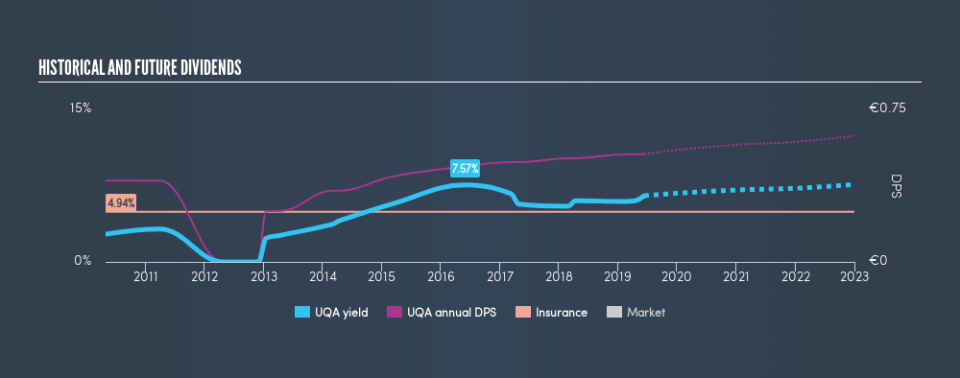Is UNIQA Insurance Group AG (VIE:UQA) At Risk Of Cutting Its Dividend?

Want to participate in a short research study? Help shape the future of investing tools and you could win a $250 gift card!
Could UNIQA Insurance Group AG (VIE:UQA) be an attractive dividend share to own for the long haul? Investors are often drawn to strong companies with the idea of reinvesting the dividends. Yet sometimes, investors buy a stock for its dividend and lose money because the share price falls by more than they earned in dividend payments.
With a goodly-sized dividend yield despite a relatively short payment history, investors might be wondering if UNIQA Insurance Group is a new dividend aristocrat in the making. We'd agree the yield does look enticing. Some simple analysis can reduce the risk of holding UNIQA Insurance Group for its dividend, and we'll focus on the most important aspects below.
Explore this interactive chart for our latest analysis on UNIQA Insurance Group!
Payout ratios
Companies (usually) pay dividends out of their earnings. If a company is paying more than it earns, the dividend might have to be cut. As a result, we should always investigate whether a company can afford its dividend, measured as a percentage of a company's net income after tax. Looking at the data, we can see that 73% of UNIQA Insurance Group's profits were paid out as dividends in the last 12 months. This is a fairly normal payout ratio among most businesses. It allows a higher dividend to be paid to shareholders, but does limit the capital retained in the business - which could be good or bad.
We update our data on UNIQA Insurance Group every 24 hours, so you can always get our latest analysis of its financial health, here.
Dividend Volatility
One of the major risks of relying on dividend income, is the potential for a company to struggle financially and cut its dividend. Not only is your income cut, but the value of your investment declines as well - nasty. The first recorded dividend for UNIQA Insurance Group, in the last decade, was nine years ago. It's good to see that UNIQA Insurance Group has been paying a dividend for a number of years. However, the dividend has been cut at least once in the past, and we're concerned that what has been cut once, could be cut again. During the past nine-year period, the first annual payment was €0.40 in 2010, compared to €0.53 last year. This works out to be a compound annual growth rate (CAGR) of approximately 3.2% a year over that time. The dividends haven't grown at precisely 3.2% every year, but this is a useful way to average out the historical rate of growth.
We're glad to see the dividend has risen, but with a limited rate of growth and fluctuations in the payments, we don't think this is an attractive combination.
Dividend Growth Potential
With a relatively unstable dividend, it's even more important to evaluate if earnings per share (EPS) are growing - it's not worth taking the risk on a dividend getting cut, unless you might be rewarded with larger dividends in future. Over the past five years, it looks as though UNIQA Insurance Group's EPS have declined at around 6.2% a year. Declining earnings per share over a number of years is not a great sign for the dividend investor. Without some improvement, this does not bode well for the long term value of a company's dividend.
Conclusion
To summarise, shareholders should always check that UNIQA Insurance Group's dividends are affordable, that its dividend payments are relatively stable, and that it has decent prospects for growing its earnings and dividend. UNIQA Insurance Group's payout ratio is within an average range for most market participants. Earnings per share have been falling, and the company has cut its dividend at least once in the past. From a dividend perspective, this is a cause for concern. With this information in mind, we think UNIQA Insurance Group may not be an ideal dividend stock.
Given that earnings are not growing, the dividend does not look nearly so attractive. Very few businesses see earnings consistently shrink year after year in perpetuity though, and so it might be worth seeing what the 6 analysts we track are forecasting for the future.
If you are a dividend investor, you might also want to look at our curated list of dividend stocks yielding above 3%.
We aim to bring you long-term focused research analysis driven by fundamental data. Note that our analysis may not factor in the latest price-sensitive company announcements or qualitative material.
If you spot an error that warrants correction, please contact the editor at editorial-team@simplywallst.com. This article by Simply Wall St is general in nature. It does not constitute a recommendation to buy or sell any stock, and does not take account of your objectives, or your financial situation. Simply Wall St has no position in the stocks mentioned. Thank you for reading.

